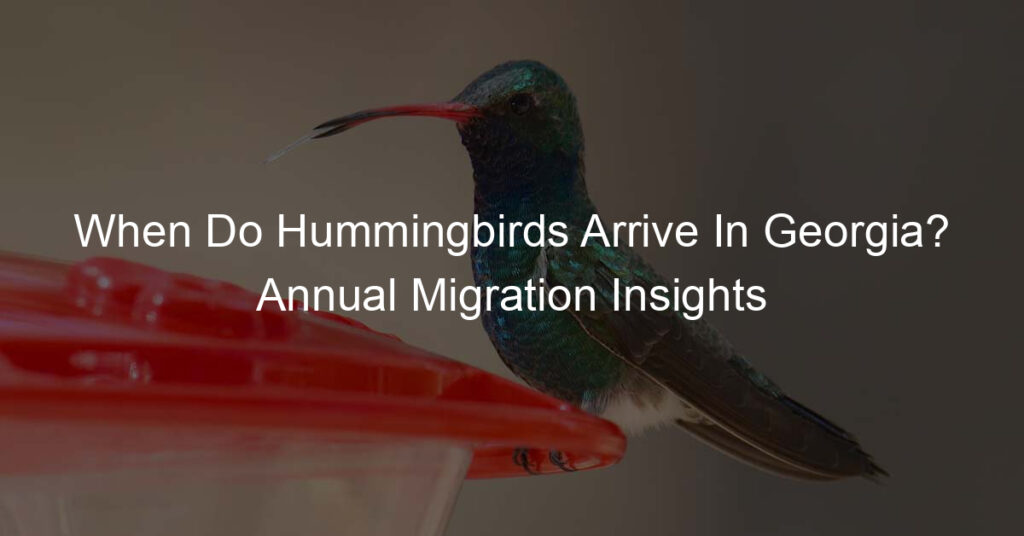As a bird enthusiast in Georgia, you’re probably anticipating the arrival of hummingbirds in your area.
These tiny, fascinating creatures are known for their quick, darting movements and their ability to hover as they extract nectar from flowers.
In Georgia, hummingbirds begin arriving as early as February into the first week of March after migrating from their wintering homes in Mexico and Central America.
Each year, thousands of these jewel-like birds flock to Georgia during their spring migration, providing residents and nature lovers with a delightful sight.
There are even a number of Ruby-throated hummingbirds that call Georgia their home year-round.
Knowing when hummingbirds will arrive can help you prepare your backyard and ensure you can enjoy them at their peak.
Key Takeaways
- Hummingbirds start arriving in Georgia as early as February into the first week of March
- Georgia is a popular place for hummingbirds during their migration, with an array of species making appearances
- Bird enthusiasts can enjoy the sight of thousands of these tiny creatures as they visit the state
When Do Hummingbirds Arrive In Georgia?
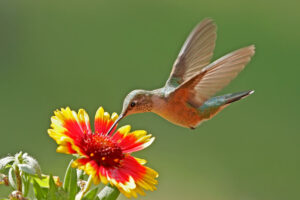
Georgia is home to multiple hummingbird species. The most commonly found species is the ruby-throated hummingbird, which is also the only one known to nest in the state.
These tiny birds bring delight to many residents and visitors as they flit among the flowers and feeders throughout the warmer months.
Although the ruby-throated hummingbird is the prominent species, other visitors include the black-chinned, rufous, calliope, magnificent, Allen’s, Anna’s, broad-billed, green violet-ear, green-breasted mango, and broad-tailed hummingbird.
These species are typically observed during migration seasons or when they occasionally stray away from their usual routes.
To attract hummingbirds to your yard, consider planting nectar-rich flowers and setting up hummingbird feeders.
Doing so provides these tiny creatures with the energy they need for their long flights.
Some popular plants for attracting hummingbirds in Georgia include trumpet vine, bee balm, and salvia.
Keep track of the hummingbird migration season in Georgia.
Migrating hummingbirds, regardless of their origin, tend to arrive in February or the first week of March.
By preparing your yard and feeders ahead of time, you’ll have the best chance of welcoming these fascinating visitors during their stay.
Signs of Hummingbird Arrival
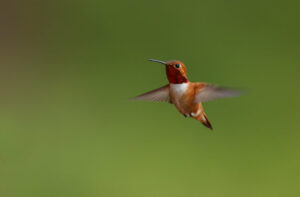
As you eagerly await the arrival of hummingbirds in Georgia, there are a few signs to look for.
These indicators can help you prepare for their return and ensure you’re ready to welcome them back.
First, pay attention to the budding of flowers and trees in your area. Hummingbirds are attracted to nectar-rich blooms, and the blooming season is usually in sync with their migration patterns.
As flowers begin to blossom in your garden, it’s likely that the hummingbirds are not far behind.
Another way to anticipate their arrival is to check the migration map provided by Hummingbirds Plus.
This map tracks the typical migration patterns of hummingbirds, and you can look for their presence in Georgia around mid-to-late March, specifically the ruby-throated hummingbird, which is the most common species in the state.
While monitoring their migration patterns, don’t forget to keep your feeders clean and full of sugar water.
Returning hummingbirds will need to replenish their energy, so having accessible food sources in your yard can help attract them.
Make sure to clean your feeders regularly to avoid any mold or bacteria that could harm these delicate creatures.
Finally, listen to the characteristic hum and chirps of hummingbirds. Their rapid wing beats emit a buzzing sound that’s easy to recognize once you’re familiar with it.
If you hear these sounds in your garden or see a sudden increase in hummingbird activity, it’s a sure sign they have arrived in Georgia.
By paying attention to these signs, you can prepare for the arrival of hummingbirds and ensure that you’re ready to welcome them back to Georgia.
Behavioral Patterns of Hummingbirds
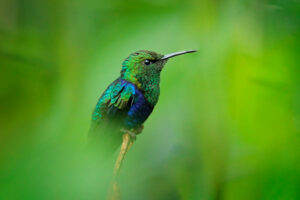
Hummingbirds are fascinating creatures known for their unique flying abilities, vibrant colors, and interesting behaviors.
As you observe these tiny birds, you’ll notice that they are highly territorial, especially when food sources are scarce.
One of the main aspects of hummingbird behavior is their grooming habits.
They often take baths and groom themselves to keep their feathers in optimal condition.
They possess an oil gland on their back, close to their tail, which they use to cover their wings using their beak.
Sometimes, they even use small twigs to help reach difficult areas.
In terms of social behaviors, hummingbirds are typically loners.
They don’t form significant social bonds and don’t mate for life. Instead, their mating process is quite brief, consisting of just a few seconds.
Feeding is also an essential component of their daily routine. Hummingbirds consume large quantities of nectar and insects for their energy needs.
They are constantly searching for food, as their high metabolism requires them to eat often.
If you’re trying to attract hummingbirds to your backyard, it’s essential to have a reliable food source such as a hummingbird feeder or nectar-rich flowers.
As for their migration patterns, hummingbirds will travel anywhere from 1,200 to 3,500 miles to reach Georgia from as far south as Panama or across the Gulf of Mexico.
They arrive in Georgia at the end of February or the beginning of March, adding their sparkling presence to the region.
Timing of Hummingbird Migration
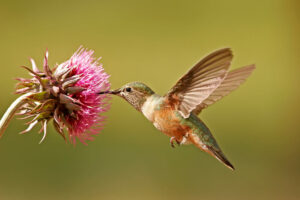
Hummingbirds typically begin arriving in Georgia around February, with some arriving as late as the first week of March.
These migrating birds may have traveled a long distance or come from somewhat closer, depending on their starting point.
As the migration season progresses, you can expect to see more hummingbirds reaching Georgia around March or April.
It’s important to note that not all hummingbirds arrive at the same time.
You may see some earlier arrivals, followed by larger groups as the season progresses.
This is due to variations in their migration patterns and their geographic starting points.
During this period, it’s a good idea to prepare for the arrival of these beautiful birds.
Setting up hummingbird feeders with clean, fresh nectar is an excellent way to attract them and provide them with much-needed nourishment.
This simple act can also provide you with countless hours of enjoyment as you watch these incredible creatures flit around your yard.
So, as February and March approach, keep an eye out for these amazing birds making their way back to Georgia.
With a little preparation and close attention, you can witness the fascinating process of hummingbird migration right in your own backyard.
Factors Affecting Hummingbird Arrival
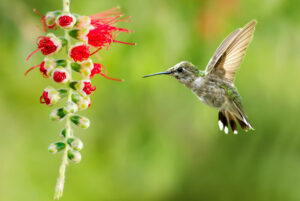
When anticipating the arrival of hummingbirds in Georgia, it is important to understand certain factors that may affect their migration pattern.
These factors contribute significantly to the timing of their arrival.
One of the primary factors that influence hummingbird migration is daylight.
The amount of daylight and the angle of the sun relative to the bird’s location play a vital role in determining their arrival time.
As light levels change seasonally, the bird’s hormones are triggered, increasing their appetite and causing them to gain weight, which is essential for fueling their long migratory journey.
Another factor that affects hummingbird arrival in Georgia is the bloom time of nectar plants.
Changing bloom times due to climate factors may present challenges for migrating hummingbirds.
Since your area’s nectar plants are critical for their food source, any variation in plant blooming might impact their presence in your area.
Lastly, the seasonal arrival of other migratory birds may also affect hummingbird migration patterns.
Some studies suggest that hummingbirds time their arrival coincides with the arrival of other bird species, which might partially depend on the local environmental conditions in Georgia.
By considering these factors, you can better predict when hummingbirds may arrive in your Georgia backyard.
Monitoring daylight levels, nectar plant blooming, and other bird migration trends in the area will make it easier to anticipate their arrival and prepare your yard to welcome these fascinating creatures.
Role of Climate Change on Hummingbird Migration
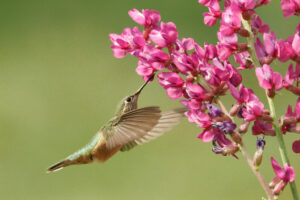
Climate change is impacting the timing of hummingbird migration, including when these birds arrive in Georgia.
Due to rising global temperatures, some species are showing shifts in their migration patterns, potentially influencing the local pollination systems.
For instance, the arrival of the Ruby-throated Hummingbird on their breeding grounds is changing as a result of Audubon.
As the climate changes, some hummingbird species are facing threats to their survival.
The Rufous Hummingbird, for example, may lose a significant portion of its current summer range by 2080 due to shifts in suitable climate Audubon.
These changes in migration timing can disrupt the delicate synchronization between migratory birds, breeding, nesting, and the availability of their food sources USGS.
It’s essential for you to understand these shifts in migration patterns to anticipate when hummingbirds will arrive in your area, as well as to support their conservation.
By keeping an eye on these fascinating little creatures, you can contribute to a better understanding of the ecological impacts of climate change and help protect these essential pollinators.
How to Attract Hummingbirds
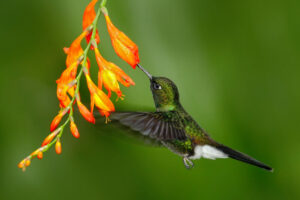
One of the best ways to attract hummingbirds to your yard is by providing them with a source of food.
You can easily create a homemade hummingbird feeder by mixing water and white sugar, which helps replicate the nectar found in flowers.
Place the feeder in a visible and accessible location, making sure to clean and replenish it regularly to maintain the birds’ interest.
Planting tubular flowers is another effective way to attract hummingbirds, as their long beaks are well-suited for accessing the nectar in these types of flowers.
Some popular options include trumpet vine, red hot poker, and bee balm.
Ensure that you choose native flowers that are appropriate for Georgia’s climate to help support the local hummingbird population.
In addition to providing food sources, you can also create a suitable hummingbird habitat by offering them a place to perch and rest.
They are often drawn to shrubby areas with dense foliage, where they can find shelter from predators and take a break from their high-energy flying.
Consider planting shrubs or small trees near your feeders to create a comfortable and inviting environment for hummingbirds.
Finally, keep in mind that hummingbirds are attracted to bright colors, especially red and orange hues.
You can incorporate these colors into your garden’s design, either by planting colorful flowers or adding decorative elements.
This color scheme will not only improve your garden’s aesthetic appeal but also serve as a beacon for hummingbirds, increasing the likelihood that they will visit your yard.
Long-Term Trends in Hummingbird Arrival Times
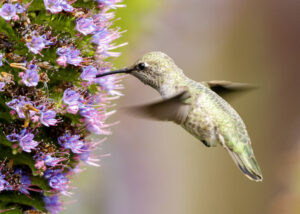
Over the years, hummingbird arrival times in Georgia have shown some variations due to different factors such as climate change and changes in habitat.
In this section, you will find a brief analysis of long-term trends in hummingbird arrival times in the state.
Traditionally, hummingbirds reach the Gulf Coast by late February or March and make their way northward.
In Georgia, this northward migration typically occurs in spring, and you can expect hummingbirds to arrive around this time.
However, the exact arrival times might change slightly each year based on various environmental factors.
Some factors that affect arrival times include:
- Climate change and global warming, which can alter migration patterns and routes
- Changes in habitat due to urbanization or deforestation, which might affect the availability of food and nesting sites
- Predation and competition from other bird species
To track the hummingbird migration and get a better understanding of their arrival times in Georgia, you can refer to the 2023 Hummingbird Migration Map.
This map will help you estimate when to expect these beautiful birds in your yard or garden.
While there are some changes in hummingbird arrival times in Georgia over the years, it is safe to say that they generally arrive in the state during the spring months.
Keeping this in mind, prepare your garden or backyard with hummingbird-friendly plants and feeders to welcome these tiny visitors when the season arrives.
Impact of Hummingbird Migration on Georgia’s Ecosystem
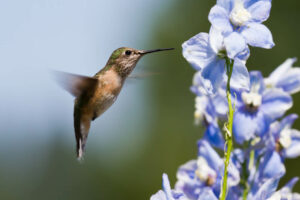
Hummingbirds play a crucial role in Georgia’s ecosystem, particularly during their migration periods.
As they arrive in Georgia, these small but powerful birds contribute to the pollination of various flowers and plants.
Pollination is essential for plant reproduction, as it enables fertilization and the production of seeds.
In this way, you can see how hummingbirds actively participate in maintaining the diversity and health of Georgia’s flora.
Another important aspect of hummingbird migration is their role in controlling insect populations.
As they feed on nectar from flowers, hummingbirds also consume small insects and spiders.
This helps to keep harmful insect populations in check, ensuring a balanced ecosystem in your area.
Furthermore, the arrival of hummingbirds in Georgia provides residents with excellent opportunities for birdwatching and engaging with nature.
Observing these fascinating birds can be a wonderful educational experience for people of all ages.
By learning about hummingbirds and their migration patterns, you can better appreciate the intricate balance of Georgia’s ecosystem and the interconnectedness of all living beings.
The migration of hummingbirds to Georgia has a significant and positive impact on the state’s ecosystem.
Their role in pollination, insect population control, and fostering a deeper appreciation for the natural world cannot be underestimated.
So, when these tiny visitors make their way back to Georgia, you can feel confident in the benefits they bring to the ecosystem.
Frequently Asked Questions
What is the typical arrival time for hummingbirds in Georgia?
Hummingbirds typically arrive in Georgia in February or the first week of March.
However, the exact arrival time can vary depending on various factors such as weather and migration routes.
It is important to keep an eye on local bird sightings to track their arrival in your area.
Which hummingbird species are commonly seen in Georgia?
The most common species of hummingbird seen in Georgia is the Ruby-throated Hummingbird.
Occasionally, other species, such as the Rufous Hummingbird or Black-chinned Hummingbird, may also be spotted in Georgia, but these sightings are quite rare in comparison to the Ruby-throated variety.
What is the best time to put out hummingbird feeders in Georgia?
To attract hummingbirds to your backyard, it is recommended to put out feeders in mid-to-late February, as this is when the first wave of migratory hummingbirds typically arrives in Georgia.
This ensures that the hummingbirds have a reliable food source as they make their journey back from their winter habitats.
When do hummingbirds migrate south from Georgia?
Hummingbirds usually start to migrate south from Georgia around late August or early September.
However, some individuals may stay in the area until late October. Pay close attention to the activity around your feeders and local bird sightings to determine when hummingbirds begin their southern migration.
Where do Georgia’s hummingbirds go during winter?
The majority of Georgia’s hummingbirds, particularly the Ruby-throated species, spend their winters in Mexico, Central, or South America.
They follow specific migratory routes to reach their wintering grounds, crossing the Gulf of Mexico in a single, non-stop flight.
Are there any rare species of hummingbirds found in Georgia?
Although the Ruby-throated Hummingbird is the most common species found in Georgia, occasionally rare species, such as the Rufous or Black-chinned Hummingbirds, can be spotted in the state.
If you think you have seen a rare hummingbird, it is important to document the sighting and report it to local birding groups or wildlife authorities.

